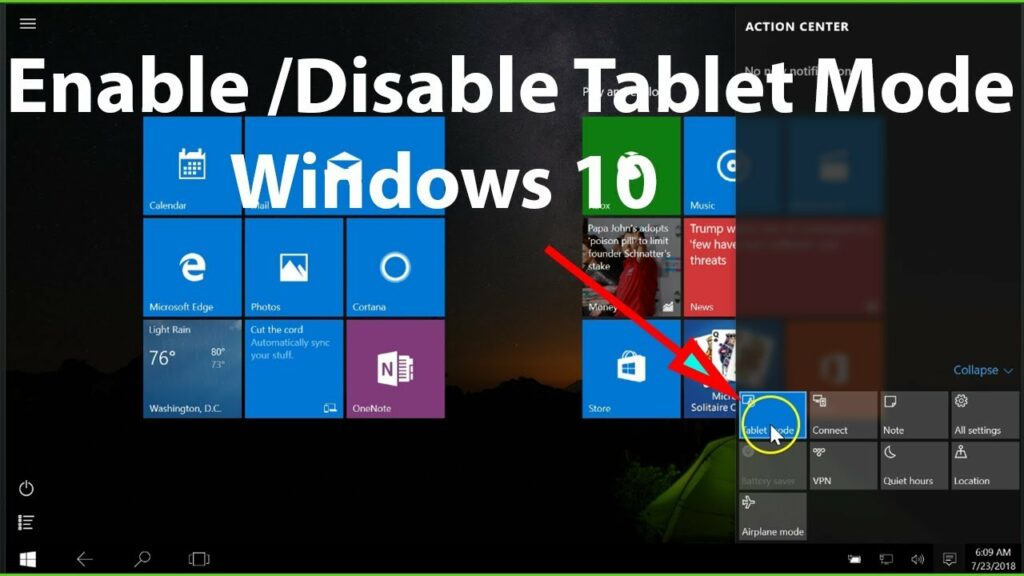Mastering Flexibility: A Comprehensive Guide on How to Enable or Disable Tablet Mode in Windows 10

Introduction
Windows 10, with its versatile interface, caters to a wide range of devices, including traditional desktops, laptops, and 2-in-1 devices. Tablet Mode is a feature designed to optimize the user experience for touch-based devices, providing a more touch-friendly interface. This comprehensive guide walks you through the steps to enable or disable Tablet Mode in Windows 10, offering users the flexibility to seamlessly transition between different modes based on their device and preferences.
Section 1: Understanding Tablet Mode
1.1 Overview
Tablet Mode in Windows 10 is specifically crafted to enhance the user experience on touch-enabled devices. When enabled, it transforms the interface for easier navigation and interaction, with larger icons, a full-screen Start menu, and a simplified taskbar.
1.2 Devices Compatible with Tablet Mode
- 2-in-1 Devices: Tablet Mode is particularly beneficial for 2-in-1 devices that can switch between laptop and tablet modes.
- Tablets: It is ideal for tablets with touch screens, providing a more intuitive interface.
Section 2: How to Enable Tablet Mode
2.1 Enabling Tablet Mode via Settings
- Open Settings: Click on the Start menu, select “Settings” (gear icon), or press
Windows key + Ito open Settings directly. - Navigate to System: In the Settings menu, select “System.”
- Access Tablet Mode Settings: Click on “Tablet” in the left pane.
- Enable Tablet Mode: Under “When I sign in,” choose “Tablet mode” from the dropdown menu.
- Additional Options: Configure other Tablet Mode settings as needed, such as the behavior of app icons on the taskbar.
- Confirmation: Once configured, Tablet Mode is enabled, and the interface will adapt accordingly.
2.2 Enabling Tablet Mode via Action Center
- Open Action Center: Click on the Action Center icon in the taskbar or press
Windows key + Ato open Action Center. - Toggle Tablet Mode: Look for the Tablet Mode icon (a square with a pen) and click on it to enable Tablet Mode.
- Confirmation: Tablet Mode is enabled, and the interface adjusts to the touch-friendly layout.
2.3 Enabling Tablet Mode Automatically
- Open Settings: Follow steps 1.1 to 1.3 in Section 2.1 to access Tablet Mode settings.
- Configure Sign-In Options: Under “When this device automatically switches tablet mode on or off,” configure the settings based on your preferences.
- Save Changes: Save the changes, and Windows 10 will automatically switch to Tablet Mode when appropriate.
Section 3: How to Disable Tablet Mode
3.1 Disabling Tablet Mode via Settings
- Open Settings: Follow steps 2.1 to 2.2 in Section 2.1 to access Tablet Mode settings.
- Disable Tablet Mode: Under “When I sign in,” choose “Use desktop mode” from the dropdown menu.
- Confirmation: Once configured, Tablet Mode is disabled, and the interface returns to the standard desktop layout.
3.2 Disabling Tablet Mode via Action Center
- Open Action Center: Follow steps 2.2 in Section 2.2 to open Action Center.
- Toggle Tablet Mode: Click on the Tablet Mode icon (a square with a pen) to turn off Tablet Mode.
- Confirmation: Tablet Mode is disabled, and the interface reverts to the traditional desktop view.
Section 4: Configuring Tablet Mode Settings
4.1 Overview
Windows 10 allows users to customize various aspects of Tablet Mode to suit their preferences and workflow.
4.2 Accessing Tablet Mode Settings
- Open Settings: Follow steps 2.1 to 2.2 in Section 2.1 to access Tablet Mode settings.
- Configure Settings: Explore options like “Hide app icons on the taskbar in tablet mode,” “Make Windows more touch-friendly,” and “Don’t ask me and always switch” to tailor Tablet Mode to your needs.
- Save Changes: Save any changes made to the Tablet Mode settings.
Section 5: Tablet Mode Tips and Tricks
5.1 Using Virtual Keyboard
- Activate Virtual Keyboard: In Tablet Mode, the virtual keyboard automatically appears when you tap on a text field.
- Customizing Keyboard: You can customize the virtual keyboard by right-clicking on its icon in the taskbar and selecting “Customize.”
5.2 Gesture Navigation
- Swipe Gestures: Tablet Mode supports swipe gestures for tasks like switching between open apps, accessing the Task View, and revealing the Action Center.
5.3 Taskbar in Tablet Mode
- Customizing Taskbar: In Tablet Mode settings, you can choose whether to hide app icons on the taskbar for a cleaner interface.
5.4 App Compatibility
- Optimized Apps: Apps from the Microsoft Store are designed to be touch-friendly and work seamlessly in Tablet Mode.
- Desktop Apps: Traditional desktop apps also work in Tablet Mode, but their interfaces may not be as touch-optimized.
Section 6: Troubleshooting Tablet Mode Issues
6.1 Overview
In some cases, users may encounter issues with Tablet Mode. Common troubleshooting steps can help resolve these issues.
6.2 Common Issues and Solutions
- Tablet Mode Not Turning On: Ensure Tablet Mode is enabled in Settings or Action Center. Restart your device if necessary.
- Touchscreen Not Responsive: Check for driver updates for your touchscreen device. Restart the device and calibrate the touchscreen if needed.
- Apps Not Scaling Properly: Some desktop apps may not scale well in Tablet Mode. Contact the app developer for updates or consider using touch-optimized alternatives.
Section 7: Conclusion
Enabling or disabling Tablet Mode in Windows 10 empowers users to tailor their computing experience based on device type and personal preferences. Whether you’re using a 2-in-1 device, a touchscreen laptop, or a traditional desktop, the flexibility of Tablet Mode enhances usability. This comprehensive guide has covered the steps to enable or disable Tablet Mode using various methods, configure settings, and provided tips for an optimal Tablet Mode experience. Experiment with Tablet Mode, explore its features, and seamlessly switch between touch-friendly and traditional desktop interfaces to make the most of your Windows 10 experience.




